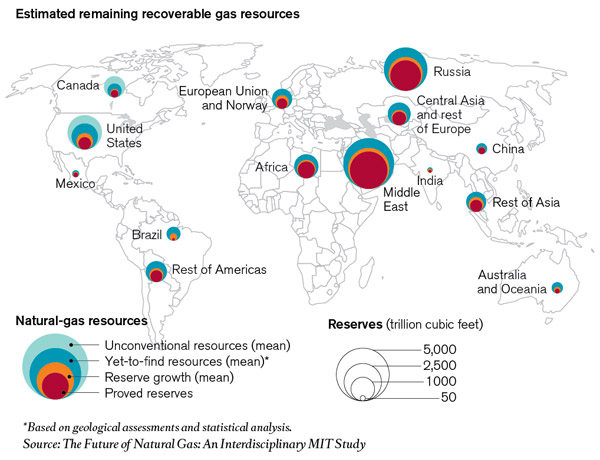Tapping an Unconventional Source

In recent years it has become clear that the United States and Canada hold a bonanza in recoverable natural gas, a resource once thought to be declining. Because natural gas releases just half as much carbon dioxide as coal when it’s burned to produce a comparable amount of electricity, the fuel could play an important role in reducing carbon emissions.
In the United States, for example, 45 percent of electricity comes from coal and 23 percent from natural gas. If half the electricity from coal were replaced with electricity from natural gas, it would eliminate 20 percent of the U.S. carbon dioxide emissions attributable to electricity generation.
Much of the optimism stems from the discovery that natural gas can be extracted economically from vast deposits of shale found across the United States (see “Natural Gas Changes the Energy Map,” November/December 2009). At current rates of consumption, those resources alone could meet U.S. demand for decades. Known worldwide supplies of natural gas add up to 150 times annual global consumption, and this estimate doesn’t include unconventional sources outside North America.
Keep Reading
Most Popular
Large language models can do jaw-dropping things. But nobody knows exactly why.
And that's a problem. Figuring it out is one of the biggest scientific puzzles of our time and a crucial step towards controlling more powerful future models.
The problem with plug-in hybrids? Their drivers.
Plug-in hybrids are often sold as a transition to EVs, but new data from Europe shows we’re still underestimating the emissions they produce.
Google DeepMind’s new generative model makes Super Mario–like games from scratch
Genie learns how to control games by watching hours and hours of video. It could help train next-gen robots too.
How scientists traced a mysterious covid case back to six toilets
When wastewater surveillance turns into a hunt for a single infected individual, the ethics get tricky.
Stay connected
Get the latest updates from
MIT Technology Review
Discover special offers, top stories, upcoming events, and more.